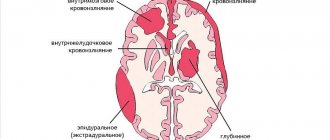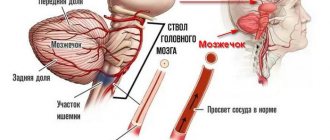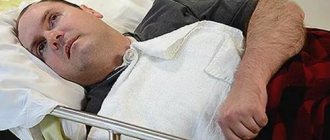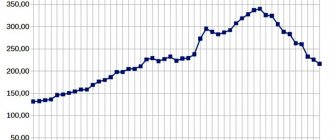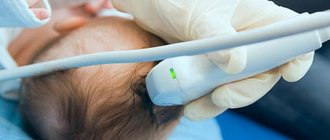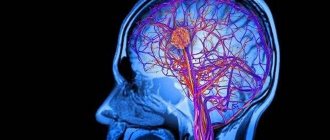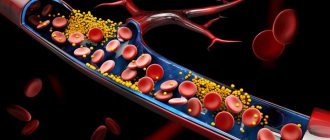First of all, when toxic substances enter the human body, brain cells are affected.
One of the most terrible diseases is toxic encephalopathy, which is characterized by endogenous disorders and unfavorable clinical outcome.
Etiology and pathogenesis of toxic encephalopathy
Encephalopathy is a non-inflammatory disease of the brain, which is characterized by a decrease in the volume of nervous tissue and a disruption of its general functioning. It can be transmitted at birth or acquired throughout life.
Congenital encephalopathy involves genetic disorders or abnormal development of the brain during fetal development. Also, this type of encephalopathy can appear due to brain damage during childbirth.
Most often, pathology occurs due to toxic substances entering the human body.
One of the most important provoking factors is alcoholism, which disrupts the structure and functioning of neurons, leading to irreversible consequences.
In alcoholism, toxic neurons enter the body from the external environment or appear due to poor functioning of internal organs. Due to damage by toxic substances, the integrity of neurons is disrupted, and foci of necrosis appear.
These lesions are located in different parts of the brain. Due to insufficient oxygen supply, various parts of the brain suffer, which leads to swelling.
Alcoholic encephalopathy
Ethanol is a common cause of nerve tissue poisoning. Experts have identified this condition as a separate pathology called “alcoholic encephalopathy.” It develops with constant consumption of alcoholic beverages, and the first signs of the disease can be detected after three years of systematic alcohol abuse.
Ethyl alcohol damages neurons and disrupts their communication. In addition, it can disrupt blood circulation in the vessels and cause the formation of blood clots. Excessive consumption of this substance contributes to the development of signs of an acute form of toxic encephalopathy:
- Attacks of dizziness.
- Loss of appetite.
- Diarrhea, flatulence, constipation, heartburn.
- Sleep disturbance, nightmares.
- Increasing weakness.
- Tachycardia, arrhythmia, rapid pulse.
The patient noticeably loses weight, his skin turns pale, and a vascular network forms on the body (mainly on the face). The disease manifests itself as a disorder of coordination of movements, trembling of the limbs. As a result of alcohol damage, mental changes occur. A person becomes nervous, aggressive, or, conversely, apathetic, prone to depression. Intellectual abilities are significantly reduced.
Experts consider Gaye-Wernicke encephalopathy to be the most dangerous type of alcoholic encephalopathy. From the first manifestations of the pathology to the death of a person, a short time passes (about two weeks). He becomes inadequate, exhausted, swollen. Hypertension and arrhythmia develop. All this is accompanied by delirium, hallucinations, and immobilization. Convulsive attacks are often recorded.
Acute and chronic forms of toxic encephalopathy
Pathology manifests itself in acute and chronic forms. The acute form of this disease is characterized by a short duration, symptoms of acute poisoning, and a deterioration in general well-being, which leads to the death of neurons.
Depending on the amount of toxic substances ingested, the onset and correct treatment of the disease, the intensity of the course varies.
In most cases, toxic alcoholic encephalopathy has a chronic form due to the constant entry of toxic substances into the human body. In this regard, complex health problems arise that require immediate treatment.
To select the correct and effective treatment for toxic encephalopathy, it is necessary to study the factors that provoked the development of pathology. If the treatment for toxic encephalopathy is chosen incorrectly, everything can end in death.
The main characteristic causes of toxic encephalopathy:
- Constant drinking of alcohol.
- Taking drugs.
- Ingestion of toxic substances into the respiratory tract.
- Man-made accidents.
- Contacts with household chemicals.
- Use of illegal drugs.
Also, the brain has severe damage due to interaction with the following components:
- Petroleum substances.
- Pesticides.
- Alcohol substances.
- Carbon monoxide.
- Carbon disulfide.
- Nitrogen compounds.
If treatment measures for toxic encephalopathy are not taken in time, a person’s health can deteriorate significantly, disability is possible, and in catastrophic situations, death of the patient.
Sometimes the symptoms of this pathology are not clearly defined, which makes it very difficult to diagnose. Sometimes, you have to wait for the symptoms of brain damage to appear in order to identify toxic encephalopathy.
Causes of pathology
Toxic encephalopathy of the brain appears under the influence of a number of provoking factors. The disease appears in people who systematically use drugs that are homemade. Patients who abuse alcoholic beverages are at risk . In case of substance abuse, which consists of regular inhalation of toxic particles, the development of the disease is diagnosed.
If a person’s activity at work involves contact with hazardous substances, then he is diagnosed with the development of toxic encephalopathy. The disease appears in unfavorable environmental conditions. If there is the presence of hazardous industrial waste or toxic emissions in the environment, this becomes the cause of pathology.
It appears when toxic substances are used incorrectly at home. The massive occurrence of toxic encephalopathy is diagnosed during man-made accidents, as a result of which there is a release of toxic substances.
The toxic type of disease appears if there is brain damage from petroleum products, alcohol, methyl alcohol, manganese, heavy metals, nitrogenous compounds, drugs, toxins, carbon monoxide, pesticides, etc. The occurrence of the disease is diagnosed against the background of exposure to toxic substances on the human body.
Symptoms of toxic encephalopathy
Main symptoms:
- Constant cramps, numbness of body parts.
- Constant headaches and dizziness.
- Neurological syndrome, which is characterized by trimmer, muscle rigidity, postural instability and other signs.
- Problems with the nervous system, which are manifested by panic attacks and nervous agitation.
- Constant bouts of vomiting.
- Problems with the cardiovascular system.
- Weight loss.
- Manifestations of vegetative-vascular dystonia.
- Problems with coordination.
At first, the symptoms of toxic encephalopathy are characterized by problems with mood, constant irritability, and aggressiveness. Further, the patient develops memory problems, and situations are possible when the patient ends up in a coma.
If the influencing factor is lead or compounds with it, then the symptoms of toxic encephalopathy have the following manifestations:
- Raising body temperature.
- Pain under the xiphoid process.
- Presence of a copper taste in the mouth.
- Increased sweating.
- Signs of tachycardia and the appearance of shortness of breath.
- Frequent vomiting.
If toxic substances of mercury enter the human body, then weakness in the body, exhaustion, tremors of the limbs and others are added to the previous symptoms.
If a person works in industries where he constantly interacts with manganese or manganese compounds, there is a high probability of manganese encephalopathy, which in most cases leads to the appearance of Parkinson's disease.
This, to a greater extent, applies to such professions as miner, welder, industrialist. Main characteristic symptoms:
- Decreased muscle tone, general weakness in the body.
- Joint pain.
- Personality degradation.
The main symptoms when arsenic enters the human body:
- Severe pain in the head.
- The appearance of white stripes on the nails.
- Hair loss.
- Peeling of the skin.
- General weakness of the body.
Alcoholic encephalopathy is easier to diagnose, as it has broader characteristic symptoms:
- Problems with the gastrointestinal tract.
- Changes in complexion and peeling of the skin.
- Manifestation of epilepsy.
- Tremor of the limbs of the body.
- Problems with cognitive functions.
- Pseudoparalysis.
- Korsakoff psychosis, which cannot be cured.
With alcoholic encephalopathy, disturbances appear in a person’s emotional state; it is characterized by irritability, aggressiveness, or the appearance of depression. Moreover, hallucinations, panic attacks and other symptoms may appear.
The most dangerous type of encephalopathy is Gaye-Wernicke encephalopathy, due to which a person can die within two weeks.
Types of disease
There are several types of toxic encephalopathy, which differ in the causes and symptoms of development:
- Alcoholic
With regular consumption of alcoholic beverages, destruction of brain cells and irreversible loss of nerve connections is observed. With pathology, patients complain of weakness and increased fatigue even when performing usual activities. Patients' body temperature rises and speech is impaired.
The pathology is accompanied by disorientation in space and memory impairment. The person cannot move independently. He is experiencing epileptic seizures.
- Manganese
When exposed to manganese, damage to the subcortical centers in the brain is observed. In case of poisoning with this substance, drowsiness, decreased muscle tone, and dull pain in the extremities are diagnosed. In severe cases, the palpebral fissures widen, the tongue trembles, and unnatural laughter or crying is diagnosed.
- Mercury
In case of mercury poisoning, abdominal pain, sweating, a blue border on the gums, and increased heart rate are observed. With pathology, patients complain of insomnia and severe weakness. The appearance of specific trembling of the arms and legs is diagnosed.
The patient's psychological state is characterized by inconsistency. If a person is in the stage of emotional upsurge, then he cannot make even the simplest decision.
- Lead
The disease appears if a person inhales dust interspersed with metal. The patient is diagnosed with purple gums, excessive salivation, nausea and vomiting. Patients report the appearance of a sweetish metallic taste in the mouth. The disease is accompanied by severe cramping pain in the abdominal area.
- Gasoline
With pathology, the brain is organically affected, which leads to convulsive seizures and increased excitability. The disease is accompanied by a delay in psychomotor development, damage to the kidneys and liver. Patients complain of restless sleep, which causes nightmares. Increased intoxication syndrome is accompanied by muscle weakness and narcolepsy.
- Arsenic
Patients report weakness in the limbs, severe pain, white stripes on the nails, peeling skin, and hair loss.
- Medicinal
The disease appears when barbiturates, glucocorticoids, bromides, isoniazid, indimetacin, salicylates, hypnotics and drugs that affect the psyche are taken incorrectly. The disease is diagnosed during the period of taking narcotic drugs, which include opium.
When poisoned by drugs, the vomiting center is excited, which causes vomiting. Patients experience headaches and mental changes. With pathology, breathing, speech and vision are impaired.
In case of toxic encephalopathy, it is recommended to determine its type, which will ensure the development of an effective treatment regimen.
Toxic encephalopathy during pregnancy
In the case of pregnancy, encephalopathy is divided into two forms: pathological or physiological.
With physiological encephalopathy, pathology can occur due to problems with the emotional background of the pregnant woman. Pathological pathology appears due to strong exposure to toxic substances.
The main causes of the pathological condition:
- Constant toxicosis.
- Liver problems.
- Atherosclerosis.
- Injury during pregnancy.
- Complications with ongoing pregnancy.
- Toxic addiction.
- Long-term vitamin deficiency.
During pregnancy, older females experience fear, acute feelings and panic attacks, which is characterized by the appearance of irritability and the emergence of a self-preservation instinct. At the same time, other symptoms of encephalopathy appear:
- Low blood pressure.
- Disorders of the vestibular apparatus.
- General weakness and exhaustion in the body.
- Inhibition of reactions.
- Blood thickening.
Due to all these symptoms, a person begins to deteriorate, concentration, memory and brain function deteriorate. In this regard, brain cells die due to the influence of toxic substances.
If any symptoms appear, you should immediately consult a doctor. A patient with encephalopathy must be immediately sent to a hospital, where a comprehensive diagnosis of the disease is carried out.
To begin with, the patient must take the necessary tests and be examined by a neurosurgeon.
Diagnostics
Treatment measures are prescribed after a complete examination of the patient and identification of the true cause of the adverse symptoms. In order to detect a high content of manganese in the brain and the process of cell death, the following diagnostic measures are carried out:
- Magnetic resonance imaging is the most accurate method. In MRI images, manganese compounds are very clearly visible. Sometimes a doctor needs to distinguish a cluster of manganese from a cluster of iron in order to identify the type of pathology - this procedure is performed without any difficulties;
- laboratory examination of blood fluid - helps to identify concomitant diseases. This is necessary so that the prescribed therapeutic measures are beneficial and not, on the contrary, worsen the patient’s condition;
- electroencephalographic study - allows you to identify the current performance of the brain. EEG is commonly used both during diagnostic procedures and during the treatment of pathology. This method of examination helps to identify the effectiveness of a particular method of therapy.
Therapeutic measures for the death of brain cells completely depend on the results of the study, the stage of the disease and the severity of the symptoms manifested. They are selected individually for each patient.
Diagnostic measures
The main goal of diagnosis is to identify a toxic substance and neutralize it to restore the normal functioning of all internal organs. Typical examinations:
- Analysis of blood, urine, feces, the results of which determine the intensity of damage to the gastrointestinal tract, liver and other organs by toxic substances.
- Electroencephalography, which is carried out at high intensity of the disease.
- MRI and CT, which establish the intensity of brain damage.
- Duplex scanning of brain vessels, which is intended to assess the degree of reduction in blood flow through the vessels.
Depending on the symptoms, intensity and form of the disease, a certain type of complex therapy is prescribed.
Thus, when prescribing treatment, the extent of the affected areas by toxic substances, the type of toxic substance and the degree of brain dysfunction are taken into account. To begin with, it is done so that the patient stops interacting with the toxic substance.
Therapy
Treatment of toxic encephalopathy consists of a set of measures. If the patient's condition is severe, then procedures are first performed to stabilize his condition. The correctness of the diagnosis plays an important role in this process. The use of modern biochemical research will help to quickly and reliably determine the type of poison.
The entire process of fixing the problem consists of several stages:
- First of all, toxic substances are removed from the body. Taking into account what kind of poison has entered the blood, saline solutions and glucose are poured into the vein, and antidotes are administered. Cleansing the body is also achieved with the help of forced diuresis, cleansing enemas, and gastric lavages. If there are indications for this, hemodialysis and plasmapheresis may be recommended. Thanks to these procedures, the effects of poison on the body are eliminated; in the future, it is important to avoid any contact with this substance.
- Eliminates symptoms of poisoning. If the patient suffers from seizures or increased excitability, then tranquilizers and sedatives are used to alleviate his condition.
- Improves blood flow through the vessels of the brain. For this, nootropic drugs like Cavinton, Piracetam, Cerebrolysin, Cinnarizine are prescribed. They can also select products based on medicinal plants and vitamin complexes.
- Acceleration of the recovery process is achieved with the use of physiotherapeutic sessions, massages of the head and collar area, acupuncture, water procedures and mud baths.
- If the functioning of the liver is impaired, means are selected to restore the functions of the organ and normalize metabolic processes in the body.
If a person is addicted to alcoholic beverages or drugs, a narcologist will talk with him. In some cases, patients should adhere to a proper diet.
There is often a need for psychotherapeutic treatment.
Treatment methods
If an endogenous influence is detected, detoxification therapy is carried out, which includes the following points:
- Gastric lavage and administration of cleansing enemas.
- Infusion of glucose and saline solutions using droppers.
- Forced diuresis.
- Hemodialysis.
- Plasmapheresis.
- Introduction of antidotes.
When the body has completely gone through the process of cleansing the toxic substance, a diagnosis is made based on characteristic symptoms. Basic recommendations:
- Tranquilizers, sedatives, antipsychotics and others are prescribed in case of characteristic mental state disorders, the presence of convulsive syndrome.
- Prescription of antihypoxants and vascular medications, as well as additional intake of vitamins to improve tissue metabolism and normal blood circulation in the brain.
- A monthly course of Essentiale Forte in order to normalize the functioning of the liver.
- Limenda, Nolpaza, Pantoprazole to improve the functioning of the gastrointestinal tract.
- Traditional medicines and sedatives to calm the emotional state.
- Additional intake of B vitamins.
To get results from treatment faster, additional physiotherapeutic procedures may be prescribed, the main ones of which are:
- Acupuncture.
- Water procedures.
- Mud baths.
- Therapeutic physical exercises.
- Massages.
- Therapies to improve emotional well-being.
Treatment and consequences
To prevent the patient’s condition from worsening, it is necessary to competently and timely treat toxic encephalopathy. It consists in the gradual elimination of brain disorders. Severe degrees of intoxication initially require stabilization of general well-being.
When the test results are ready and the type of toxic substance is determined, the following is carried out:
- Removing toxins from the body using intravenous infusion of antidotes, glucose, and saline solutions. Artificial stimulation of urine excretion using special means, gastric lavage, and cleansing enemas are actively carried out. In severe cases, hemodialysis and plasmapheresis are used to cleanse the blood.
- Measures to eliminate symptomatic manifestations. For example, for convulsive seizures (epileptic seizures), increased excitability and other mental disorders, sedative, psychotropic, and anticonvulsant medications are used.
- Restoring blood circulation and cellular metabolism of the brain with the help of medicines, vitamin complexes, and preparations made from natural ingredients.
During rehabilitation, intensive physical therapy is performed. Patients are prescribed medicinal baths and massage. If internal organs are affected, it is necessary to use medications that restore their function. In case of poisoning associated with regular use of drugs or alcohol, the patient is assisted by a narcologist and psychotherapist.
The success of treating conditions that cause damage to brain tissue and structures largely depends on the provoking factor and the severity of the pathological process. With chronic encephalopathy in an advanced stage, it will not be possible to completely get rid of the consequences (memory deterioration, tendency to depression, sleep disorders, psycho-emotional imbalance), because profound changes in the nervous system cannot be restored.
Prevention
Also, it is imperative to prevent the disease, no matter what it develops. First of all, the consumption of alcohol, toxic drugs, and unsafe pills is prohibited. Prevention is to improve the body's protective functions. Basic recommendations:
- Balanced diet.
- Walking outside.
- Sports lifestyle.
- Taking courses of vitamins.
- Control of production and environmental factors.
If the disease is not diagnosed in time, it is almost impossible to return a person to a normal and familiar way of life, since brain cells do not die without a trace.
The intensity of damage by toxic substances depends on the amount and size of necrosis, as well as the resuscitation actions taken.
Symptoms
The nature of the manifestation of signs of the disease depends on the area of localization of dead brain cells and the functions for which they were responsible. In the first stages of toxic poisoning, the patient experiences unreasonable mood changes, frequent attacks of aggression, increased irritability, apathy, and lack of perception of the world around him. For a child in society, such psychological attacks can become very dangerous, because peers, classmates, animals, etc. can suffer from aggression. The child's psyche is very fragile and the child is not able to control the manifestation of symptoms. Further, necrosis of brain cells is accompanied by the manifestation of autonomic disorders:
- hot and cold flashes;
- increased sweating;
- the appearance of dandruff;
- rapid pollution, grease, hair loss;
- brittle nails;
- suffocation of the condition of the skin.
Often, at the initial stage of the pathological process, the patient and his parents are not aware of the development of a dangerous disease, so it goes into a more advanced stage.
Long-term progression of manganese encephalopathy in children - symptoms
has more pronounced The patient notices signs of parkinsonism (manganese parkinsonism), since this disease is also caused by the death of brain cells that are responsible for maintaining muscle tissue in tone. As a result of the progression of the pathology, the muscles of the face, torso, upper and lower extremities are constantly in good shape. Toxic poisoning not only causes hardening of muscle tissue, but also provokes their involuntary contraction. Typically, violent, uncontrolled movements affect the lower extremities.
Unreasonable manifestation of the above symptoms indicates the need to immediately visit a medical facility, undergo a full examination and begin treatment for a dangerous disease. If such signs are ignored, the patient faces disability, deteriorated functioning of all vital organs, and subsequently death.
Types of encephalopathy
This disease has several varieties, which can be divided into two large groups:
- Congenital encephalopathy. Its cause, as a rule, is metabolic failures, malformations of the brain, or negative factors affecting the fetus during pregnancy. This diagnosis can be made to a newborn in the maternity hospital after an ultrasound of the brain.
- Acquired. This form of the disease can overtake anyone, as it can be provoked by a variety of factors. Depending on this, it is divided into several varieties.
- Traumatic. Easy to get as a result of injury or fracture.
- Toxic encephalopathy. It can occur after exposure to various toxins in the brain.
- Radial. Develops as a result of exposure to radiation.
- Toxic-infectious occurs as a result of damage to the brain by toxins during infectious diseases.
- Metabolic encephalopathy. Associated with metabolic disorders in certain diseases, such as diabetes.
- Vascular occurs in chronic circulatory disorders.
As can be seen from this list, getting yourself such a disease is not difficult.

